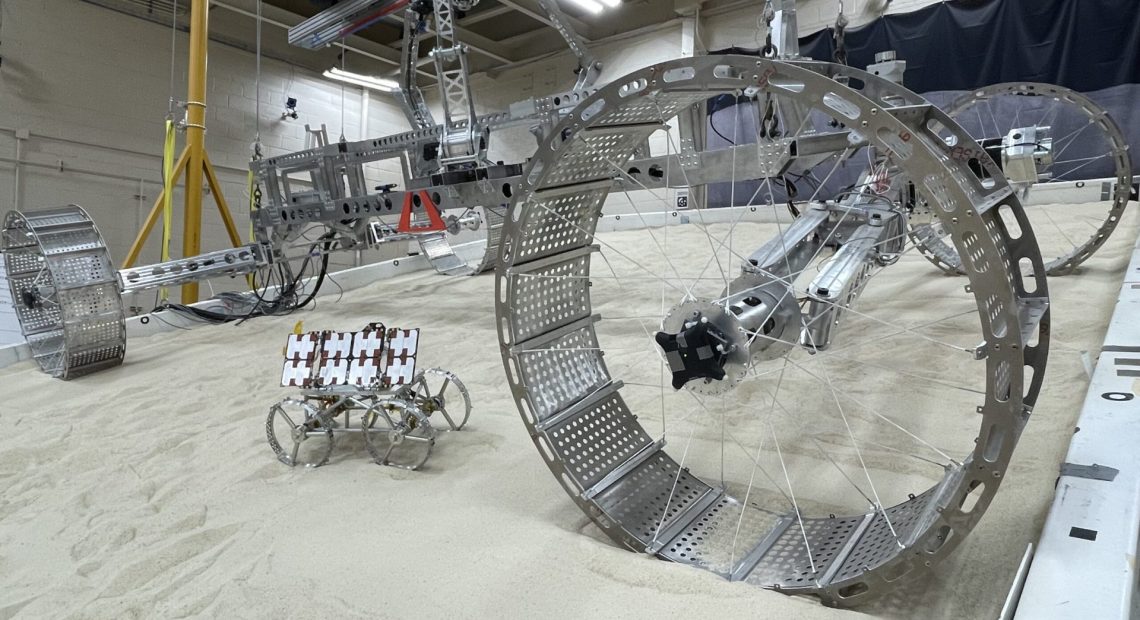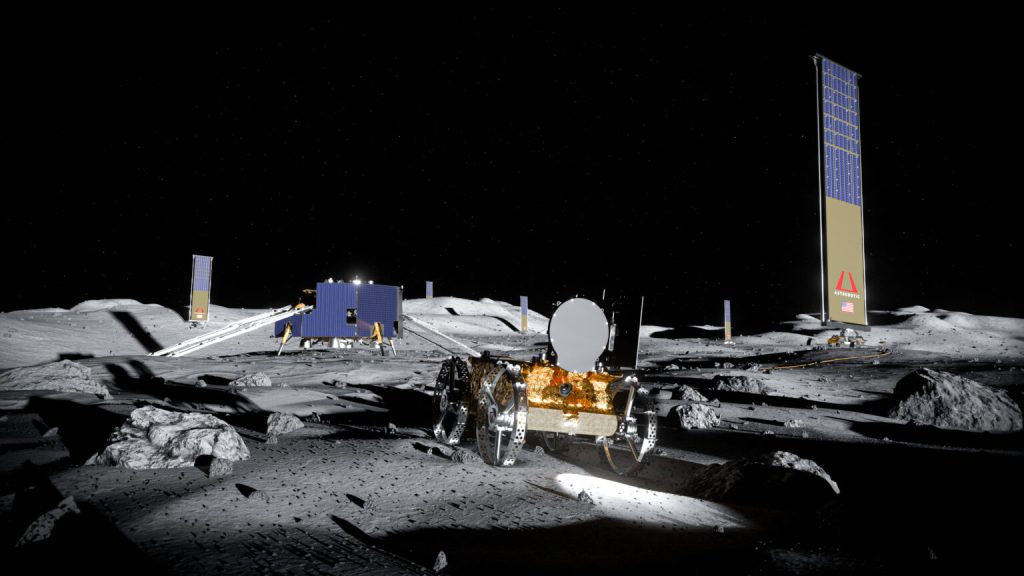Astrobotic lunar rover finishes slope tests at NASA facility

VOLT is a key element of LunaGrid platform
Astrobotic Technology, the Pittsburgh, Pennsylvania-based lunar exploration company, has completed surface stability testing of its revolutionary lunar rover, the VSAT Optimised for Lunar Traverse (VOLT).
The VOLT rover, equipped with an innovative vertical solar array, has undergone rigorous stability testing at NASA’s Glenn Research Centre in Cleveland. The Simulated Lunar Operations Laboratory (SLOPE) testing assessed the vehicle’s performance on inclines and its ability to maintain stability and functionality on the lunar surface.
Designed to operate at the Moon’s South Pole, VOLT is a cutting-edge lunar rover that aims to harness solar energy to power various lunar surface assets, including habitats, rovers, and scientific instruments.
The rover’s engineering model was tested on an inclined bed of lunar regolith simulant, mimicking the harsh and uneven terrain expected on the Moon.
During the tests, VOLT demonstrated impressive stability, surpassing its design expectations. While engineered to handle a 15-degree incline, the rover remained stable on a 20-degree slope without any slippage.
3-degree tolerance
The gimbal system, crucial for orienting the solar array and maintaining stability on uneven terrain, performed within a 3-degree tolerance, confirming its reliability in keeping the 60-foot vertical solar array level. NASA Glenn’s advanced motion capture cameras validated VOLT’s stability and performance on the simulated lunar surface.

Robert Rolley, Astrobotic’s Principal Investigator for VOLT, emphasised the results’ significance: “To ensure continuous power supply at the lunar poles, we must utilise locations with constant sunlight throughout the year.
“Many of these locations are on crater rims with steep slopes, so we designed VOLT to operate effectively on extreme inclines. These tests have proven that our system meets and exceeds the necessary performance criteria, providing a substantial margin for even more challenging locations.”
The successful completion of the testing phase follows an intensive development period for the VOLT rover.
12 weeks
Astrobotic’s team engineered, prototyped, and assembled the rover’s mobile base—a structure comparable in size to a minivan—in just 12 weeks. The gimbal system, integral to the rover’s operation, enables the vertical solar array to track the sun 360 degrees autonomously, ensuring optimal energy capture and system stability on uneven lunar terrain.
VOLT is designed to be delivered to the Moon aboard Astrobotic’s Griffin lunar lander, which will operate independently without additional towing equipment.
VOLT is a critical component of Astrobotic’s LunaGrid system, which aims to create a network of tethered VOLTs to provide power across the lunar surface. This power will be distributed through wired connections and wireless chargers on tethered cuberovers, which will act as mobile power sources.
The LunaGrid system is designed to enable lunar systems to operate throughout the lunar day and endure the lunar night for extended periods.
John Landreneau, Senior Project Manager at Astrobotic, highlighted the importance of this advancement: “Solving the power-generation challenge on the Moon is crucial for sustainable long-term operations. VOLT’s precise driving capabilities and operational efficiency in prime solar capture areas distinguish it from other technologies.
“With our strategic partnerships and innovative in-house developments, the VOLT and LunaGrid systems are progressing well toward providing reliable power to various lunar surface systems.”
VOLT engineering model
Astrobotic plans to unveil the fully assembled VOLT engineering model at the annual Keystone Space Conference, scheduled for October 28-29, 2024, in Pittsburgh. The company anticipates deploying and demonstrating LunaGrid elements on the lunar surface by mid-2026 to achieve the first operational LunaGrid by 2028 at the Moon’s South Pole.
In related developments, Astrobotic’s Vertical Solar Array Technology (VSAT), essential for harnessing solar energy for the lunar power grid, is preparing to enter thermal vacuum (TVAC) testing at NASA’s Johnson Space Centre.
This follows the recent successful testing of the VOLT rover at NASA’s Glenn Research Centre. The VSAT, in collaboration with Redwire Space, will be assessed in Chamber A at Johnson Space Centre, further validating the integrated system’s readiness for lunar deployment.
The LunaGrid system, designed to deliver power to various lunar surface systems, is set to revolutionise lunar operations. By enabling systems from multiple entities—including companies, governments, universities, and non-profits—to survive the lunar night and function indefinitely at the lunar South Pole, Astrobotic’s innovations are paving the way for a new era of lunar exploration and utilisation.
Featured image: Astrobotic’s VOLT rover undergoing testing at NASA Glenn Research Centre’s SLOPE Lab. The rover is pictured with a cuberover alongside. Credit: Astrobotic













